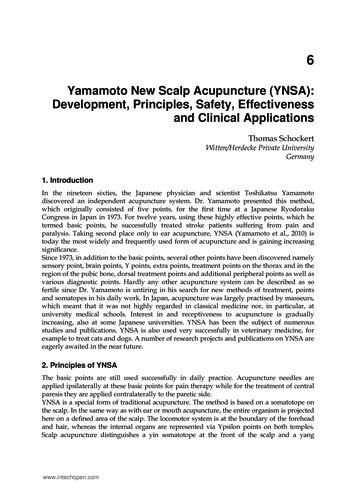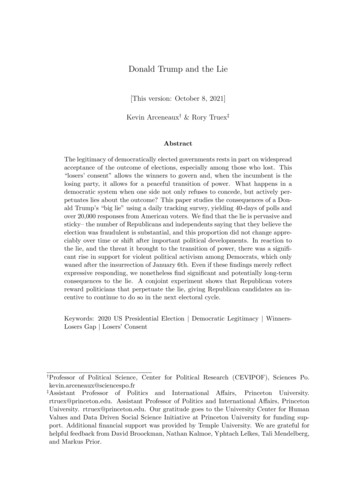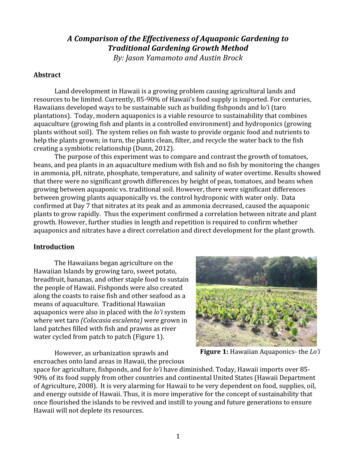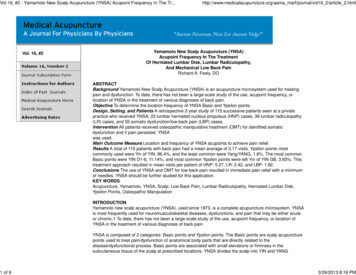
Transcription
Vol 16, #2 - Yamamoto New Scalp Acupuncture (YNSA) Acupoint Frequency In The Tr.Vol. 16, #2http://www.medicalacupuncture.org/aama marf/journal/vol16 2/article 2.htmlYamamoto New Scalp Acupuncture (YNSA)Acupoint Frequency In The TreatmentOf Herniated Lumbar Disk, Lumbar Radiculopathy,And Mechanical Low Back PainRichard A. Feely, DOABSTRACTBackground Yamamoto New Scalp Acupuncture (YNSA) is an acupuncture microsystem used for treatingpain and dysfunction. To date, there has not been a large-scale study of the use, acupoint frequency, orlocation of YNSA in the treatment of various diagnoses of back pain.Objective To determine the location frequency of YNSA Basic and Ypsilon points.Design, Setting, and Patients A retrospective 2-year study of 115 successive patients seen at a privatepractice who received YNSA: 22 lumbar herniated nucleus propulsus (HNP) cases, 38 lumbar radiculopathy(LR) cases, and 55 somatic dysfunction/low back pain (LBP) cases.Intervention All patients received osteopathic manipulative treatment (OMT) for identified somaticdysfunction and if pain persisted, YNSAwas used.Main Outcome Measure Location and frequency of YNSA acupoints to achieve pain relief.Results A total of 115 patients with back pain had a mean average of 3.17 visits. Ypsilon points mostcommonly used were Yin of YIN, 86.4%, and the least common were Yang/YANG, 1.6%. The most commonBasic points were YIN D1-6, 11.14%, and most common Ypsilon points were left Yin of YIN GB, 3.65%. Thistreatment approach resulted in mean visits per patient of HNP: 5.27, LR: 2.42, and LBP: 1.82.Conclusions The use of YNSA and OMT for low back pain resulted in immediate pain relief with a minimumof needles. YNSA should be further studied for this application.KEY WORDSAcupuncture, Yamamoto, YNSA, Scalp, Low Back Pain, Lumbar Radiculopathy, Herniated Lumbar Disk,Ypsilon Points, Osteopathic ManipulationINTRODUCTIONYamamoto new scalp acupuncture (YNSA), used since 1973, is a complete acupuncture microsystem. YNSAis most frequently used for neuromusculoskeletal diseases, dysfunctions, and pain that may be either acuteor chronic.1 To date, there has not been a large-scale study of the use, acupoint frequency, or location ofYNSA in the treatment of various diagnoses of back pain.YNSA is composed of 2 categories: Basic points and Ypsilon points. The Basic points are scalp acupuncturepoints used to treat pain/dysfunction of anatomical body parts that are directly related to thedisease/dysfunctional process. Basic points are associated with small elevations or firmness in thesubcutaneous tissue of the scalp at prescribed locations. YNSA divides the scalp into YIN and YANG1 of 93/29/2013 8:16 PM
Vol 16, #2 - Yamamoto New Scalp Acupuncture (YNSA) Acupoint Frequency In The Tr.http://www.medicalacupuncture.org/aama marf/journal/vol16 2/article 2.htmlwherein YIN is the anterior/frontal (Figure 1) and YANG is the posterior/dorsal part of the scalp (Figure 2).YIN is further divided into Yin of YIN and Yang of YIN. YANG is also further divided into Yin of YANG andYang of YANG. YNSA acupuncture also uses Ypsilon points, which relate to the 12 acupuncture meridians(Figure 3). To identify which acupuncture point needs treatment, Yamamoto developed a palpatory neckdiagnosis technique (Figure 4). YNSA neck diagnosis is a palpatory procedure to determine which Ypsilonquadrant needs to be treated (Yin of YIN, Yang of YIN, Yin of YANG, Yang of YANG) and which Ypsilon pointneeds treatment.Ypsilon points represent all the acupuncture meridians except CV and GV. The 12 acupuncture meridians,LU, LI, KI, BL, HT, SI, LR, GB, PC, TB, SP, and ST, are identified by palpatory neck tenderness in specificareas (Figure 4). The YNSA neck diagnostic palpatory tenderness findings indicate which Ypsilon point totreat and which side of the scalp. The hardness or softness of the sternocleidomastoid muscle (SCM) is usedto indicate in which Ypsilon quadrant (YIN or YANG) to place the needle in the respective Ypsilon point.1METHODSI conducted a retrospective 2-year study relating to clinical findings of YNSA performed on patients in aprivate osteopathic manipulative medicine ambulatory practice. Data were gathered using the clinicaldocumentation of each patient's medical record including history, demographics, physical signs, symptoms,imaging study results, diagnoses, and treatment. The selection of patients was determined by whether theyreceived YNSA and if the treatment was for 3 types of back pain: magnetic resonance imaging(MRI)-documented symptomatic herniated lumbar disk/herniated nucleus propulsus (HNP), lumbarradiculopathy (LR), and mechanical low back pain/somatic dysfunction (LBP). All patients were adults whohad areas of somatic dysfunction in the lumbar, sacrum, pelvis, and pain. Every case of HNP wasdocumented by positive findings on MRI. All LR cases were documented by positive neurological signs oflumbar root nerve irritation, and some with negative MRI findings. Mechanical LBP was documented bypositive signs of somatic dysfunction and pain, with negative MRI findings and radiculopathy.Figure 1. YNSA basic points Yin2 of 93/29/2013 8:16 PM
Vol 16, #2 - Yamamoto New Scalp Acupuncture (YNSA) Acupoint Frequency In The Tr.http://www.medicalacupuncture.org/aama marf/journal/vol16 2/article 2.htmlFigure 2. YNSA basic points YangFigure 3. YNSA Ypsilon – Points (Yin or Yang, left or right)3 of 93/29/2013 8:16 PM
Vol 16, #2 - Yamamoto New Scalp Acupuncture (YNSA) Acupoint Frequency In The Tr.http://www.medicalacupuncture.org/aama marf/journal/vol16 2/article 2.htmlFigure 4. YNSA neck diagnostic test pointsOsteopathic ManipulationOsteopathic manipulation is a well-documented effective modality in the treatment of biomechanical LBP/somatic dysfunction.2 Osteopathic manipulative manual techniques were used to identify areas of somaticdysfunction in the entire axial skeleton and the lower appendicular skeleton. A variety of manipulative4 of 93/29/2013 8:16 PM
Vol 16, #2 - Yamamoto New Scalp Acupuncture (YNSA) Acupoint Frequency In The Tr.http://www.medicalacupuncture.org/aama marf/journal/vol16 2/article 2.htmlprocedures, including high velocity/low amplitude, articulatory, muscle isometric "muscle energy," myofascialrelease, and cranial osteopathic manipulative procedures, were used with the end result of relievingmechanical restrictions/somatic dysfunction, improving range of motion, and decreasing pain, edema, andsoft tissue texture changes.3 The lumbar spine and its related structures were determined to be adequatelytreated biomechanically and by the patient's physiological response of that day. The patient was then queriedabout pain and tenderness that persisted with active as well as passive range-of-motion tests. Patients withpersistent pain were then evaluated for the necessity of YNSA by palpatory findings of the He gu points andthe neck diagnosis techniques. Most patients had a marked diminution of pain after osteopathicmanipulation, but it was not complete. Thus, YNSA was indicated and after patient consent, YNSA wasinitiated.Acupuncture Treatment: YNSAYNSA was determined to be necessary by physical examination and history of the patient and palpatorytenderness associated with He gu point LI 4 of the left or the right hand. Tenderness of LI 4 is indicative ofthe sidedness, left or right, to initiate YNSA neck diagnosis technique.The hardness or softness of the sternocleido mastoid muscle (SCM) indicates which quadrant should bepiqued. The 4 quadrants are Yin of YIN, Yang of YIN, Yin of YANG, and Yang of YANG (Figure 3). A hardSCM indicates treatment is needed in Yin of YIN; a soft SCM indicates treatment is needed in Yang of YANG.YNSA Basic points for the spine diagnosis techniques were used to determine the necessity of YNSAacupuncture; for example, D 1-6, which represents the lumbar spine, correlated directly to the YNSA neckdiagnosis lumbar tender point. Other neck diagnosis tender points were used, both Basic and Ypsilon, in theappropriate quadrants as determined by the YNSA method. All YNSA neck diagnosis tender points weretreated until there was no tenderness in the neck area after proper needle placement.For acupuncture: a single needle wasplaced over the appropriate YNSA point inthe appropriate quadrant by palpation forslight elevation of the subcutaneoustissue, and an acupuncture needle wasplaced in a tube with a vertical insertion,then needling was performed. After theneedle was inserted, it was tonified with aclockwise motion less than 360 . As aroutine, Basic YNSA neck tender pointswere treated first. The Ypsilon pointsfollowed based on positive YNSA neckdiagnosis.1Table 1. 10 Most Common AcupointsMost FrequentAcupointsLeft Yin of YIND1-6Right Yin of YIND1-6Right Yin of YIN ALeft Yin of YINGBAfter there was no neck tenderness, using Left Yin of YIN ALeft Yin of YIN BLthe YNSA neck diagnosis method, theHegu point was then tested forLeft Yin of YIN KItenderness. If there was no tenderness,the acupuncture treatment ended. The5 of 9HNPLR% LBP(n 22) (n 38) (n 13 8:16 PM
Vol 16, #2 - Yamamoto New Scalp Acupuncture (YNSA) Acupoint Frequency In The Tr.patient was then questioned whetherhe/she had significant pain relief.Each patient was treated in my privateosteopathic/medical acupuncture practice.Each patient signed a consent fortreatment. During the course of treatmentand research, each patient's identity waskept confidential.For each treatment, demographic data ofthe patient were gathered along withinformation regarding other diagnoses atthe time of treatment as well as othertreatments given such as osteopathicmanipulation, traditional Chineseacupuncture, Chinese herbs, injections,and/or medications. For each treatment,every YNSA point used was documented.Data were first separated by each specificdiagnosis i.e., HNP, LR, and LBP. The datawere then combined to provide adescriptive overview of the treatment ofback pain.RESULTSA total of 115 patients with back pain weretreated. There were 51 men and 64women, with a mean age of 47.5 years(range, 16-87 years). They were dividedinto 3 groups:1. 22 HNP, 116 total points used; Left2.3.http://www.medicalacupuncture.org/aama marf/journal/vol16 2/article 2.htmlRight Yin of YINM2Left Yin of YINPCRight Yin of YINGBLeft Yin of YINM2Right Yin of YINC2Left Yin of YINM1Left Yin of YIN C2Right Yin of YinBLRight Yin of YINM1Right Yin of YIN ELeft Yin of YIN 521.282.984.670.751.511.32Abbreviations: HNP, herniated nucleus propulsus; LR, lumbarradiculopathy; and LBP, somatic dysfunction/low back pain.Table 2. Frequency of Use for YNSA YpsilonQuadrantsYang of YANG1.6%Yang of YIN3.8%Yin of YANG8.2%Yin of YIN86.4%Abbreviation: YNSA, Yamamoto New Scalp Acupuncture.Yin/YIN D1-6 most common Basicpoint and Left Yin/YIN GB most common Ypsilon point (6 most common were D1-6, A, GB, M1, C2,KI)38 LR, 92 total points used; right Yin/YIN D1-6 most common Basic point and Right Yin/YIN GB mostcommon Ypsilon point (6 most common were D1-6, A, M2, C1, M1, GB)55 LBP, 100 total points used; Left Yin/YIN D1-6 most common Basic point and Left Yin/YIN GB mostcommon Ypsilon point (6 most common were D1-6, GB, BL, M2, KI, and PC).The effectiveness of YNSA was evident in the immediate temporary relief of pain on nearly all visits (patientsstated they had significant pain relief and a vast majority of cases had 100%.) The number of YNSA6 of 93/29/2013 8:16 PM
Vol 16, #2 - Yamamoto New Scalp Acupuncture (YNSA) Acupoint Frequency In The Tr.http://www.medicalacupuncture.org/aama marf/journal/vol16 2/article 2.htmltreatments required on average to more permanently relieve pain was 3.17 visits per patient (HNP: 5.27, LR:2.42, and LBP: 1.82). Table 1 lists frequencies of 10 most common Basic and Ypsilon points used. Ypsilonpoint frequency was decidedly in favor of Yin of YIN at 86.4%, with the least being Yang of YANG 1.6%(Table 2).DISCUSSIONThe data presented here of herniated nucleus propulsus, lumbar radiculopathy, and mechanical LBP offermaterial support for the contention that YNSA is an effective form of microsystem acupuncture that appearsto be successful in relieving acute and chronic LBP from a variety of causes. This may be the first study toverify what Dr Yamamoto has been teaching his students for more than 20 years. While relatively unknown inthe United States, YNSA deserves recognition and further research into its reliability and validity as well asits compatibility with other forms of treatment. YNSA is another form of acupuncture that complements thetraditional Chinese medicine (TCM) teachings while providing new insights into the electromagnetic circuitryof the body.4The most common Basic and Ypsilon points needing treatment are found in Yin of YIN. The distribution of the4 phases of YNSA were as expected (Tables 1, 2) based on YNSA theory, which states that most commonfindings for Ypsilon treatment are Yin of YIN. The next most common quadrant being treated in all cases wasYin of YANG, then Yang of YIN, and the least commonly used was Yang of YANG.The leading Ypsilon point required by YNSA neck diagnosis was Gallbladder (GB). The GB meridian is thecontroller of the soma of the body, tendon, fascia, and muscles in TCM theory; it would logically, from a TCMperspective, fit into that paradigm.The most common basic point was logically the D 1-6 point for lumbar spine anatomy; neurology, myofascial,and osteology. The percentages were exactly the same for left and right side. D1-6 was by far the mostsignificant point in treating all types of LBP studied.The use of A point (cervical) and M2 (cerebrum), M1 (basal ganglia) was higher in LBP with neurologicalinvolvement than with only mechanical LBP. This makes sense in that the neurobiological feedbackmechanism is present when the spinal nerves are irritated by chemical and/or anatomical means, and theYNSA Basic points provide a positive effect. On the other hand, mechanical LBP due to myofascial-articularsprains and strains associated with somatic dysfunction was found to require treatment with D1-6 first andthen Ypsilon (meridian) points, and not usually the Basic points.This study describes the frequency of visits for each LBP entity and the number of needles used on averageto achieve pain relief. The documentation supports the contention that YNSA is an effective adjunct ineliminating pain whether it is from biomechanical, inflammatory, or anatomically compressive spinalneurological pain.Osteopathic manipulation was used to address the biomechanical component of the disease. The use ofosteopathy for all cases had an effect on modifying the physiology, changing joint motion, function, and pain.Then, since the pain was not 100% relieved after the first manipulation, YNSA was used to treat the patientfrom a bioelectrical/energetic perspective. This self-selection criterion causes a bias for more difficult casesto be treated with YNSA.7 of 93/29/2013 8:16 PM
Vol 16, #2 - Yamamoto New Scalp Acupuncture (YNSA) Acupoint Frequency In The Tr.http://www.medicalacupuncture.org/aama marf/journal/vol16 2/article 2.htmlThe limitations of this study are multiple, namely, that it is a retrospective study of 115 patients selected andnot randomized. Second, those patients agreeing to acupuncture may have been treated by this methodbefore and have had expectations that could cause a placebo effect. Third, the accuracies of documentationinclude lack of a visual analog pain scale on each visit. Fourth, other complementary treatments were used,which could have had an effect on the patient's physiological response in addition to the acupuncture. Finally,pharmaceutical treatment was used in some cases. More study is warranted in the new area of scalpacupuncture.CONCLUSIONThe use of YNSA scalp acupuncture has been shown to be effective in reducing LBP, resulting in immediaterelief with a minimum of needles, usually 6 or fewer. The most frequent Basic acupoint used was D1-6; theYpsilon point was GB, located in the Yin of YIN quadrant. YNSA provides a check-and-balance system withimmediate input and response to and from the patient with the YNSA neck diagnosis method. The 4quadrants of the Ypsilon points were found to be most common in Yin of YIN, Yin of YANG, Yang of YIN, andthen Yang of YANG.ACKNOWLEDGEMENTSI wish to acknowledge Heather Puder for assisting in the collection, presentation, and computation of thedata presented in this article, and thanks to artist Christine Kelley for the drawings presented in this article.REFERENCES1. Yamamoto T, Yamamoto H. Yamamoto New Scalp Acupuncture. Tokyo, Japan: Axel Springer Japan2.3.4.Publishing Inc; 1998.Andersson GBJ, Lucente T, Davis AM, et al. A comparison of osteopathic spinal manipulation withstandard care for patients with low back pain. N Engl J Med. 1999;341(19):1426-1431.Kimberly PE, Funk SL. Outline of Osteopathic Manipulative Procedures. Kirksville College ofOsteopathic Medicine. Marceline, MO: Walsworth Publishing Co; 2000.Miltiades K. Neuroscience, neurophysiology and acupuncture. The Medical Acupuncture Web Page.1996. http://users.med.auth.gr/ karanik/english/ neuro1.htm. Accessed January 26, 2004.AUTHOR INFORMATIONDr Richard Feely has a private practice, Feely Ltd, in Chicago, Illinois. He specializes in OsteopathicManipulative Medicine as well as TCM andYNSA acupuncture.Richard A. Feely, DO, FAAO, FCA, FAAMA*150 East Huron St, Ste 1104Chicago, IL 60611Phone: 312-266-8565 Fax: 312-266-0495 E-mail: rafeely@drfeely.com*Correspondence and reprint requests8 of 93/29/2013 8:16 PM
Vol 16, #2 - Yamamoto New Scalp Acupuncture (YNSA) Acupoint Frequency In The Tr.http://www.medicalacupuncture.org/aama marf/journal/vol16 2/article 2.htmlHome Contact Information SearchCopyright 2001 American Academy of Medical Acupuncture. All Rights Reserved.9 of 93/29/2013 8:16 PM
Yamamoto new scalp acupuncture (YNSA), used since 1973, is a complete acupuncture microsystem. YNSA is most frequently used for neuromusculoskeletal diseases, dysfunctions, and pain that may be either acute or chronic.1 To date, there has not been a large-scale study of the use, acupoint frequency, or location of
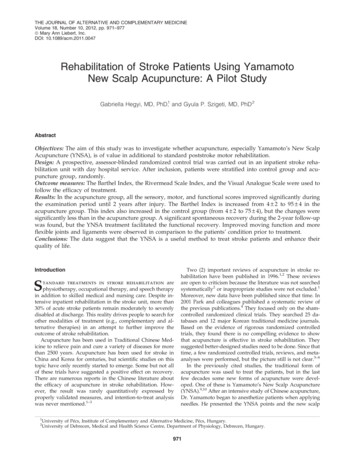
![[T] Effects of Ai Chi and Yamamoto new scalp acupuncture on chronic low .](/img/60/camilotti-bm-et-al-2015-low-back-pain-and-ai-chi-2.jpg)
